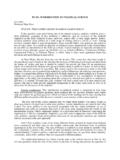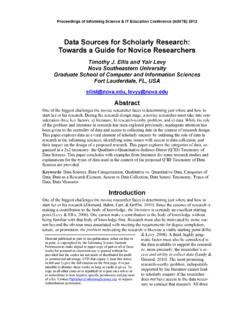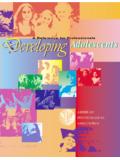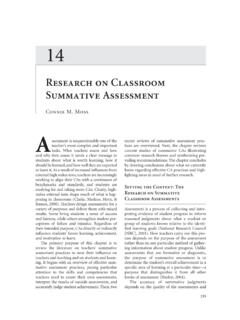Transcription of What Causes Homosexuality? - Family Research Council
1 1 what Causes Homosexuality? This is the first and perhaps the most basic question about homosexuality . In order to understand the phenomenon of same-sex sexual relations, we must first explore what the Research shows about the origins of such attractions. There are two main theories as to what Causes homosexual attractions. One is that a homosexual orientation is essentially dictated by genetic and or bio-logical factors put simply, that people are born gay. The other theory is that homosexual attractions develop as primarily as a result of psychological and environmental influences and early experiences. In the public square, the latter theory has appeared to be in decline and the former gaining favor in recent decades.
2 But what does the Research show? Let s look at these two theories in turn. Are People Born Gay? While the Research of the infamous sex researcher Alfred Kinsey is often used by those seeking the moral approval of homosexuality , there is one point on which he is seldom quoted: his rejection of a biological origin for homosexu-ality. Kinsey s colleague and biographer, Wardell Pomeroy, reports: By the end of 1940 he had recorded more than 450 homosexual histories, enough to convince him that the psychologists were making mat-ters worse by starting with the assumption that homosexuality was an inherited abnormality which could not be cured simply because it was inherent.
3 Kinsey was convinced that there was absolutely no evidence of inheritance. Wardell B. Pomeroy, Dr. Kinsey and the Institute for Sex Research (New York: Harper & Row, 1972), Alleged evidence of the biological origin of homosexualityA handful of studies published during the 1990s have claimed to offer evidence in favor of a biological or genetic cause for homosexuality . Three of these in particular a study of brain structure by Simon LeVay, a study of twins by J. Michael Bailey and Richard C. Pillard, and a study of gene linkage and gene markers by a team led by Dean H.
4 Hamer attracted considerable media attention and are largely responsible for the popular belief that a gay gene has already been found. Let s look at these in Brain Studies of Simon LeVaySome researchers have theorized that the sexual preferences and behavior of homosexuals may be dictated by the structure of the brain particularly if the brains of homosexual men, for example, can be shown to resemble those of heterosexual women more than they resemble those of heterosexual men. One highly publicized study that purported to demonstrate this was conducted in 1991 by former Salk Institute researcher Simon LeVay. LeVay studied the brains of cadavers, including 18 men known to have been homosexual and one known to have been bisexual.
5 He compared them with the brains of another 16 men and six women whom he presumed to have been heterosexual. This is what LeVay claimed to have found: INAH 3 was more than twice as large in the heterosexual men as in the women. It was also, however, more than twice as large in the heterosexual men as in the homosexual men. This finding indicates that INAH is dimorphic with sexual orientation [ , shows a dif-ference in structure between homosexuals and heterosexuals], at least in men, and suggests that sexual orientation has a biological substrate. Simon LeVay, A Difference in Hypothalamic Structure Between Heterosexual and Homosexual Men, Science, 253: 1034 (August 1991).
6 Weaknesses of LeVay s study LeVay s study, however, suffered from serious methodological errors, including the failure to adequately identify a control group. LeVay made questionable assumptions regarding the orientation of the heterosexual cadavers. He assumed that they were all heterosexual, 3even though a number of the allegedly heterosexual subjects had died of AIDS, a disease that remains far more common among homosexual men than among heterosexuals: Sixteen subjects were presumed to be heterosexual men: six of these subjects died of AIDS and ten of other Causes . LeVay, A Difference in Hypothalamic Structure Between Heterosexual and Homosexual Men, 1035.
7 Another anomaly of LeVay s study was the fact that three of the heterosexuals had brain clusters smaller than the mean size for the homosexuals. On the other hand, three of the homosexuals had larger clusters than the mean size for heterosexuals. Thus, LeVay was forced to admit, The existence of exceptions in the present sample (that is, presumed heterosexual men with small INAH 3 nuclei, and homosexual men with large ones) hints at the possibility that sexual orientation, although an important variable, may not be the sole determinant of INAH 3 size. Ibid. LeVay, in fact, admitted that his claim of a correlation between this brain structure and sexual orientation could not prove causation, or even the direction of influence, noting that [T]he results do not allow one to decide if the size of INAH 3 in an individual is the cause or consequence of that individual s sexual orientation, or if the size of INAH 3 and sexual orientation co-vary under the influence of some third, unidentified variable.
8 Ibid. All 19 of his homosexual subjects had died of AIDS, and LeVay noted that another problem was the possibility that AIDS patients constitute an unrepresentative subset of gay men, characterized, for example, by a tendency to engage in sexual relations with large num-bers of different partners or by a strong preference for the receptive role in anal intercourse, both of which are major risk factors in acquiring human immunodeficiency virus (HIV ) infection. Ibid. A related issue is that the allegedly smaller brain clusters might not have caused homosexuality , but instead could have resulted from sexual activity or AIDS-related brain damage.
9 [T]here is the 4 possibility that the small size of INAH 3 in the homosexual men is the result of AIDS or its complications and is not related to the men s sexual orientation. He further allowed that until tissue from homosexual men dying of other Causes becomes available, the pos-sibility that the small size of INAH 3 in these men reflects a disease effect that is peculiar to homosexual AIDS patients cannot be rigor-ously excluded. Ibid., researchers reject LeVay s findings William Byne and Bruce Parsons, writing in Archives of General Psy-chiatry, also raised the question of how AIDS could have impacted LeVay s subjects, concluding that it is possible to hypothesize a plausible mechanism by which human immunodeficiency virus infection could account for a selective reduction in the volume of INAH3 in the homosexual men.
10 Byne and Parsons also challenge LeVay s use of animal studies to support the notion that the INAH3 is crucial to the generation of male-typical sexual behavior. Finally, they conclude that LeVay s study can be faulted for a number of technical flaws, such as a variable method of tissue fixa-tion, inadequate sexual histories, and small sample sizes. William Byne and Bruce Parsons, Human Sexual Orientation: The Biologic Theories Reap-praised, Archives of General Psychiatry, 50: 235 (March 1993).Other Brain StudiesTheories concerning the anterior commissureSince LeVay, researchers have examined other areas of the brain to see if there are differences between homosexuals and heterosexuals.



















